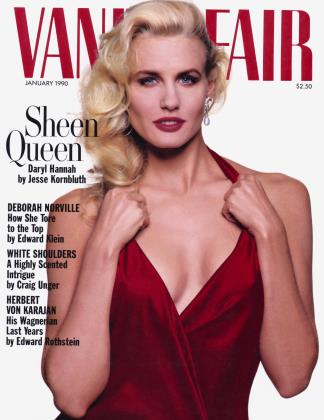Sign In to Your Account
Subscribers have complete access to the archive.
Sign In Not a Subscriber?Join NowEditor's Letter
ComingofAge
Happy New Decade! Vanity Fair grew up as an eighties boom-child, but we come of age in the nineties. We have evolved from a magazine of popular culture selling 200,000 copies to a magazine of extradimensional news selling three-quarters of a million. Popular culture still flourishes in V.F., but side by side with stories that interpret, dramatize, and probe. In 1989 alone we were all over the map. From Pakistan, Edward Jay Epstein reconstructed the last plane ride of General Zia and came up with conclusions that were news to the State Department. Alex Shoumatoff went into the Brazilian rain forest to document the assassination of eco-martyr Chico Mendes, and into the contraband stew of Paraguay to reveal the dark truth about the deposed "Tyrannosaur," General Alfredo Stroessner. T. D. Allman sat in a desert tent with Qaddafi, flew in Arafat's jet, took cocktails with the postBaby Doc kleptocrats of Haiti, and talked in Tiananmen Square with the Chinese student who made the Goddess of Democracy statue. Everyone had heard about Mrs. Reagan's Just Say No campaign, but as William Safire wrote in The New York Times it was V.F.'s Leslie Bennetts who revealed why the former First Lady had pulled out of her much-publicized commitment to the Phoenix House drug rehabilitation program. And on the cultural front, when Baryshnikov stunned the ballet world in late September with his resignation from the American Ballet Theatre, only Vanity Fair was backstage to sort truth from rumor, in Stephen Schiff's timely November cover story, "The Prince Bows Out."
Media know-it-alls are always saying that "people don't read anymore." We have news for them. They do. Our reader appeal is often attributed to the fact that we have shorter articles than any of the more "serious" magazines. We don't. We have longer articles. And our circulation growth is correlated not to an increase in froth but to the increase in substance. All the articles I have just mentioned, and others like them, such as William Styron on his depressive illness, Gail Sheehy on Mrs. Thatcher, Ron Rosenbaum on Judge Roth wax, and Marie Brenner on Michael Milken, required space—and we gave it to them in spades. We have the writers who can justify it—and the intelligent readership that responds to it. We do the same this month with Edward Rothstein's haunting portrait of the last years of Herbert von Karajan. V.F. regularly publishes articles of 10,000 to 15,000 words at a time when magazines such as Time, Newsweek, and The New York Times Magazine can stretch to only half that length. If V.F.'s articles linger in the mind as "short," we are delighted; it's a tribute to the gifts of the best magazine writers in America today. They will be with you in the nineties, registering the crosscurrents of our electric age.
Editor in chief
 View Full Issue
View Full Issue












Subscribers have complete access to the archive.
Sign In Not a Subscriber?Join Now